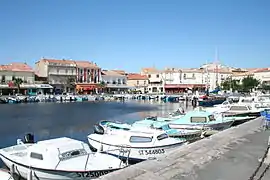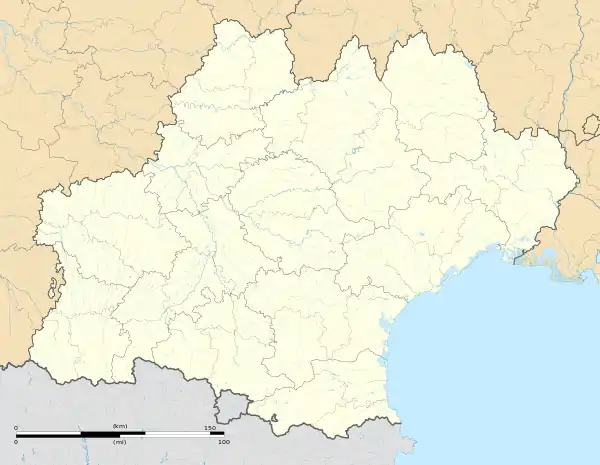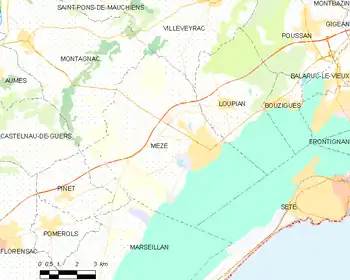Mèze | |
|---|---|
 Harbour | |
.svg.png.webp) Coat of arms | |
Location of Mèze | |
 Mèze  Mèze | |
| Coordinates: 43°25′40″N 3°36′21″E / 43.4278°N 3.6058°E | |
| Country | France |
| Region | Occitania |
| Department | Hérault |
| Arrondissement | Montpellier |
| Canton | Mèze |
| Intercommunality | CA Sète Agglopôle Méditerranée |
| Government | |
| • Mayor (2021–2026) | Thierry Baëza[1] |
| Area 1 | 34.59 km2 (13.36 sq mi) |
| Population | 12,664 |
| • Density | 370/km2 (950/sq mi) |
| Time zone | UTC+01:00 (CET) |
| • Summer (DST) | UTC+02:00 (CEST) |
| INSEE/Postal code | 34157 /34140 |
| Elevation | 0–75 m (0–246 ft) (avg. 20 m or 66 ft) |
| 1 French Land Register data, which excludes lakes, ponds, glaciers > 1 km2 (0.386 sq mi or 247 acres) and river estuaries. | |
Mèze (French pronunciation: [mɛz]; Occitan: Mesa; Phoenician: Mansa) is a commune in the Hérault department in southern France.
Its inhabitants are called Mézois.
Geography

Situated on the étang de Thau, Mèze shares with Bouzigues its historic role as the oyster capital of the area. Almost a third of its inhabitants depend on the fishing industry for their livelihood. In recent years, tourism and transport have become increasingly central to the local economy.

History
An important port since Phoenician times, Mèze has always primarily been a fishing town. During the Roman Empire, the town lay on the main Southern route from Italy to Spain - the 'Via Domitia'. The Romans brought wine to the area and left a legacy of architecture including two of the town's churches. The production of shellfish, especially oysters, has been the mainstay of the Mèze economy for almost a century and the whole Bassin de Thau area has built an international reputation for the quality of its seafood.
Administration
| Term | Mayor of Mèze | Party |
|---|---|---|
| 1807–1815 | Michel Privat | |
| 1815–1817 | Charles de Borie | |
| 1817–1820 | Pierre Ronzier | |
| 1820–1828 | Louis Charamaule | |
| 1828–1840 | François Bouliech | |
| 1840–1848 | de Borie | |
| 1848-1848 | Santy | |
| 1848–1849 | Hippolyte Bouliech | |
| 1849-1849 | Frédéric de Girard | |
| 1849–1850 | Jules Molinier | |
| 1850–1851 | François Besse | |
| 1851-1851 | Sylla Lacroix | |
| 1851–1859 | Constantin Bouliech | |
| 1859–1865 | Adrien Lonjon | |
| 1865–1870 | Gustave Privat | |
| 1870–1874 | Antonin Bouliech | |
| 1874–1876 | Emile Molinier | |
| 1876-1876 | Jean-Baptiste Allègre | |
| 1876–1878 | Jean-François Besse | |
| 1878-1878 | Benjamin Durand | |
| 1878–1880 | Jean-Baptiste Allègre | |
| 1880–1882 | Emile Beaumadier | |
| 1882–1885 | Jean-Baptiste Allègre | |
| 1885-1885 | Vincent Germain | |
| 1885–1887 | Jean-Baptiste Allègre | |
| 1887–1892 | Guillaume Gros | |
| 1892–1901 | Paulin Arnaud | |
| 1901–1904 | Paul Enteric | |
| 1904–1912 | Baptiste Guitard | |
| 1912–1921 | Paul Enteric | |
| 1921–1922 | Louis Brun | |
| 1922–1923 | Camille Fraisse, Charles Poujol, François Vailhe |
délégation spéciale |
| 1923–1925 | Julien Granal | |
| 1925–1941 | Méril Poujade | |
| 1941–1944 | Thomas Bessiere | délégation spéciale |
| 1944–1947 | Henri Bessède | |
| 1947–1971 | André Montet | |
| 1971–1977 | Georges Jean | |
| 1977–2001 | Yves Pietrasanta | Greens |
| 2001-2001 | Yvon Pibre | |
| 2001-2021 | Henry Fricou | Greens/Europe Écologie–The Greens |
| 2021-2026 | Thierry Baëza | Génération écologie |
Population
| Year | Pop. | ±% p.a. |
|---|---|---|
| 1968 | 5,005 | — |
| 1975 | 5,508 | +1.38% |
| 1982 | 5,742 | +0.60% |
| 1990 | 6,502 | +1.57% |
| 1999 | 7,630 | +1.79% |
| 2007 | 10,336 | +3.87% |
| 2012 | 10,917 | +1.10% |
| 2017 | 11,587 | +1.20% |
| Source: INSEE[3] | ||
Sights

%252C_%C3%89glise_de_Saint-Martin_de_Caux.jpg.webp)
- Old village center
- Port Mèze: both a working fishing harbor and a port for recreational boating.
- Lagunage ecological site
- Dinosaur Plain' palenthology museum.
- Eglise Saint Hilaire
- La Chapelle des Pénitents (12th century)
- Le château de Girard (end of 17th century)
- Remains of city walls
- St-Jean-de-la-Garrigue, former parish church, built in romanesque style.
Personalities
- The French Arabist and historian André Miquel was born in Mèze.
- Singer Pierre Vassiliu lived for many years in Mèze.
- Singer Christian Delagrange lives in Mèze.
Festivals
- Music Festival de Thau (annual),
- A festival of traditional Boat Jousting is held each summer.
Traditions
- The legendary bœuf de Mèze has become the animal symbol of the town.
- The Balle au tambourin ball game.
See also
References
- ↑ "Répertoire national des élus: les maires". data.gouv.fr, Plateforme ouverte des données publiques françaises (in French). 1 February 2022.
- ↑ "Populations légales 2021". The National Institute of Statistics and Economic Studies. 28 December 2023.
- ↑ Population en historique depuis 1968, INSEE
External links
- (in French) Website of panoramic photos of Mèze and its region
- (in French) Official site
- (in French) Festival of Thau